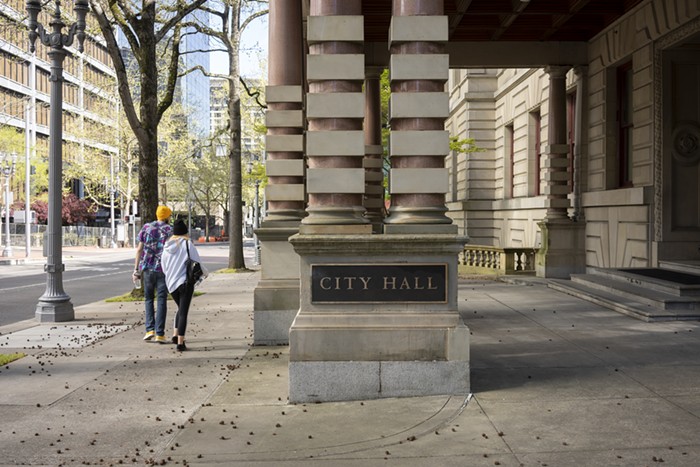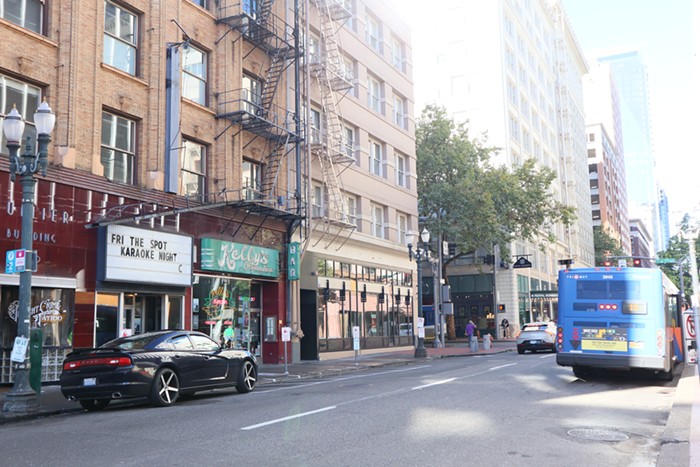Approval was 3-0, with Nick Fish and Dan Saltzman leaving before the vote. The money will come from the city's contingency fund—it's piggy bank for priorities and other issues that crop up outside quarterly budget reviews. Withdrawing the money, after also taking money for a scholarship program and sex trafficking, will leave that fund with $463,268 through June 30.
"This is about all of us," said Commissioner Amanda Fritz. "This is about treatment. This isn't an either/or."
The plan amounts to a new look at the old drug-free zones left to expire in 2007 because they targeted black Portlanders to a disproportionate degree. But this time, the exclusions based on convictions, not arrests, and set by the DA's office and judges, with treatment also offered. Neighbors put heat on the mayor to do something after police budget cuts allowed the Old Town/Chinatown drug market to rev up uncomfortably.
Last I wrote about the plan, I clamored for money to be spent on actual policing, not just on the DA's post. I'm told as much as half the money would be used to cover police overtime budgets to add some patrol heft.
The plan, sought by many in Old Town, remains controversial, sparking concerns that the new "impact areas" will be every bit as constitutionally fraught as the old DFZs, or nothing more than a way to target the homeless. More than two-dozen people signed up to address the council—although many had to leave before getting their turn at the microphone, because debate on the plan was bumped from the morning agenda to the afternoon agenda.
But city and police bureau officials praised the idea, unsurprisingly. So did the business community and some Old Town neighbors. Mike Kuykendall, the police bureau's civilian director of services and the guy in charge of connecting with the district attorney's office, compared the new exclusions to others meted out by judges and prosecutors over the years, for gang violence as one example. The DA's office needed a promise of funding before it would begin work crunching numbers and plotting the stay-away zones
"It's not an unheard of concept," Kuykendall said. "It happens every day in the courthouse."
Kuykendall also referenced a report from the bureau today that Old Town police efforts pushed by the mayor while he was still mulling over the new IDIAs had resulted in some 32 people being sent to the grand jury this week on drug charges. (See the release pasted below.)
Commissioner Randy Leonard—a vocal opponent of the old DFZs—hammered on the arrests vs. convictions difference and focused on the program's tie to the Service Coordination Team as a means of delivering treatment to people in need. Earlier, Kuykendall and Chief Mike Reese pointed out that the SCT program had empty beds, and had a graduate of the program (whom they've used for other media coverage) address the council.
That didn't sit well with Chani Geigle-Teller from Sisters of the Road, an opponent of the plan who demanded for more attention on medical and social solutions to drug trafficking, and less on legal solutions.
"It's amazing there are empty beds," she said. "There should never empty beds."
One issue that came up was whether the "impact areas" will just displace drug sales and drug crimes across the river or to other parts of downtown. Adams acknowledged "there will likely be some displacement." But because of the planned treatment provisions, he said "our hope is that the displacement will be much less than when it was simply trespass based on an arrest."
Adams later mentioned the millions the city has spent on housing and other social services and challenged foes to "find a better program in another city."
"This is one piece of the puzzle," Amanda Fritz said before joining Leonard and Adams in support of the proposal. "It's a compassionate, holistic approach. It know that's hard to believe.... I'm grateful the details will be worked out by the judge"—allowing probation conditions to be tailored to each individual offender.
Here's the cop shop's release.
Officers from the Portland Police Bureau's Central Precinct Street Crimes Unit and Neighborhood Response Team conducted undercover drug missions for several weeks in March 2011 in the Old Town neighborhoods affected by street level drug dealing and drug use.32 people were indicted on a variety of drug charges including Delivery of a Controlled Substance, Possession of a Controlled Substance, Delivery of an Imitation Controlled Substance, Delivery of a Controlled Substance Within 1000' of a School, and Felon in Possession of a Weapon.
The list of persons (and ages) indicted:
Hilson Bernard Derrow, 28
Chad Allen Hornsby, 36
Kamai Elontae Allen, 35
Trumaine Griffin, 28
Calvin Tayborn, 44
Otis King Porchia, 58
Kevin Eugene Bridges, 46
Eric Lester Fennell, 45
Michael Tyrone Carr, 44
Jack Lamar Yoalkum, 24
Donnie Michael Willis, 43
Eugene McNeely, 28
John Conrad Keller, 47
Donnie Earl Baines, 35
Irvin Lee Johnson, 50
Allen Ronald Williams, 47
James Russell Rogers, 43
Marvin Douglas Ross, 51
Brad Lydell Lindsey, 52
Marcel Lamar McDonald, 23
Lennon Drew Smith, 50
Robert Green, 41
Igitia Elenore Johnson, 29
Ophelia Marie Hill, 27
Clifford Amerson Jr., 39
Taurian Alford, 40
Antoine Tyrone Young, 21
Kendell Mack, 32
James Simms, 45
Theresa Reba Mozell White, 44
Larry Muchelle Davis, 54
Melodie Ann Leffall, 46Many of those indicted have already been arrested on warrants are currently in the Multnomah County Jail.
Beginning tonight and going through Sunday April 24, 2011, Central Precinct Officers will be on extra patrol in Old Town and will be operating the Mobile Command Center, which will be in the area of Northwest 4th and Couch and Northwest 5th and Flanders.
These missions are part of the ongoing efforts to reduce street level drug dealing and livability issues in the Old Town/Chinatown neighborhoods.













